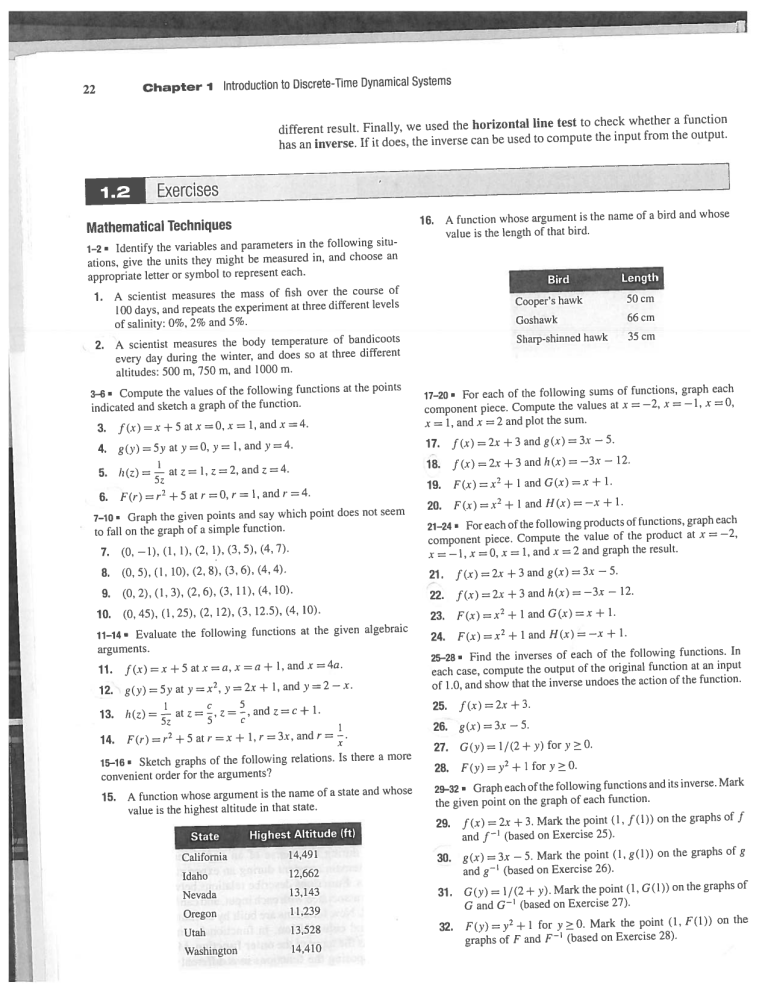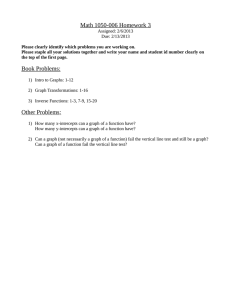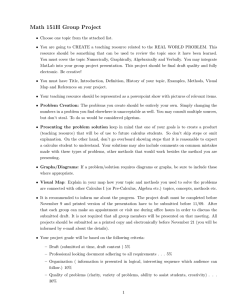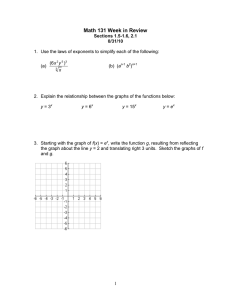_______________________________ Introduction to Discrete-Time Dynamical Systems 22 Chapter 1
advertisement

Chapter 1 22 Introduction to Discrete-Time Dynamical Systems l line test to check whether a function different result. Finally, we used the horizonta used to compute the input from the output. has an inverse. If it does, the inverse can be and whose A function whose argument is the name of a bird bird. that of value is the length 16. Mathematical Techniques ing situ 1—2. Identify the variables and parameters in the follow an choose and ations, give the units they might be measured in, each. appropriate letter or symbol to represent of 1. A scientist measures the mass of fish over the course levels nt differe three at ent 100 days, and repeats the experim of salinity: 0%, 2% and 5%. bandicoots 2. A scientist measures the body temperature of different three at so does and , winter the every day during altitudes: 500 m, 750 m, and 1000 m. at the points 3—6. Compute the values of the following functions indicated and sketch a graph of the function. 4. f(x)=x+5atx=0,x=1,andx=4. g(v)=5yaty=0,y=l,andy=r4. 5. h(z)=-— atz=l,z=2,andz:=4. 3. r4. dr=r = l,an ,r=) (r 5atr=0 2 F + does not seem 7—10 • Graph the given points and say which point n. to fall on the graph of a simple functio 6. 7. 8. 9. 10. (0, —1), (1, 1), (2, 1), (3, 5), (4,7). (0, 5), (1, 10), (2, 8), (3, 6), (4,4). (0, 2), (1, 3), (2,6), (3, 11), (4, 10). (0, 45), (1,25), (2, 12), (3, 12.5), (4, 10). algebraic 11—14 • Evaluate the following functions at the given arguments. 11. f(x)=zx+Satx=a,x=a+1,andx=z4a. aty=x y=2x + 1, andy=2 —x. , 12. N g(y)—5v 2 5 c 1 ,z=—,andz=c+1. 13. h(z)=—atz=— c 5 5 14. . F(r)=r2+5atr=x+1,r=3x,andr= a more 15—16 • Sketch graphs of the following relations. Is there ents? convenient order for the argum and whose 15. A function whose argument is the name of a state state. that in e t value is the highes altitud State Highest Altitude (ft) California 14,491 Idaho 12,662 Nevada 13,143 Oregon 11,239 Utah 13,528 Washington 14,410 Length Bird Cooper’s hawk 50 cm Goshawk 66 cm Sharp-shinned hawk 35 cm ns, graph each 17—20 • For each of the following sums of functio = —1, x =0, x —2, = x at values the te Compu component piece. sum. the plot and 2 = x and x = 1, 17. f(x)=2x+3andg(x)=3x —5. 18. f(x)=2x+3andh(x)=—3x— 12. F(x)_—x + 1 and G(x)=x + 1. 2 19. 1. x =—x+ )= dH(x) (x lan 2 F + ns, graph each 21—24’ For each of the following products of functio t at x = —2, produc the of value the te component piece. Compu result. the graph and 2 = x and 1, = x x —1, .r = 0, 20. 21. f(x)=2x+3andg(x)=3x—5. 22. f(x) =2x +3 and h(x) 23. . x =x+1 )= dG(x) (x lan 2 F + l. x =—x+ )= dH(x) (x lan F + 2 24. = —3x — 12. functions. In 25—28 • Find the inverses of each of the following n at an input functio l origina the each case, compute the output of the function. of action the undoes inverse the of 1.0, and show that 25. f(x)=2x+3. 26. g(x)=3x—5. 27. G(’)z= l/(2+v) fory0. 28. =y + 1 fory0. 2 F(v) inverse. Mark 29—32. Graph each of the following functions and its n. the given point on the graph of each functio raphsoff 29. f(x)=2x+3.Markthepoint(l,f(l))ontheg and f (based on Exercise 25). graphs of g g(x) = 3x —5. Mark the point (1, g(1)) on the 26). se and g (based on Exerci graphsof 31. G(y)=1/(2+y).Markthepoint(1,G(1))onthe 27). se Exerci on G and G (based on the l for y0. Mark the point (1, F(1)) 32. 2 F(y)=v + 28). se Exerci on (based F and graphs of F 30. Find the compositions of the given functions. Which pairs of functions commute? 33—36 • 2x + 3 and g(x) f(x) 34. f(x)=2x+3andh(x)=—3x— 12. 35. 2 + I and G(x) =x + 1. F( —r 36. F(x)=x- + I and H(x)= —x ±. 1. = A plot of an Internet stock price against time. 160 140 120 3x —5. 33. = 40. 23 Exercises 1.2 ioo “ 40 20 0 0 10 5 15 20 25 Time (days) Applications Describe what is happening in the graphs shown. 37—40 • 37. A plot of cell volume against time in days. • 41. A population of birds begins at a large value, decreases to a tiny value, and then increases again to an intermediate value. 42. The amount of DNA in an experiment increases rapidly from a very small value and then levels out at a large value before declining rapidly to 0. 43. Body temperature oscillates between high values during the day and low values at night. 44. Soil is wet at dawn, quickly dries out and stays dry dur ing the day, and then becomes gradually wetter again during the night. 2 45—48 • Evaluate the following functions over the suggested range, sketch a graph of the function, and answer the biological question. Time (days) 38. Draw graphs based on the following descriptions. 41—44 45. The number of bees b found on a plant is given by b = 2f ± I where f is the number of flowers, ranging from 0 to about 20. Explain what might be happening when f = 0. 46. The number of cancerous cells c as a function of radiation dose r (measured in rads) is A plot of a Pacific salmon population against time in years. 1000 c = r —4 800 for r greater than or equal to 5, and is zero for r less than 5. r ranges from 0 to 10. What is happening at r = 5 rads? 600 400 47. Insect development time A (in days) obeys A = 40 where T represents temperature in C for 10 T 40. Which temperature leads to the more rapid development? 48. Tree height Ii (in meters) follows the formula 200 0 1950 1960 1970 1980 — 1990 Year 39. Ii A plot of the average height of a population of trees plotted against age in years. 10 8 6 - 0 10 20 Age (years) 30 40 = lOOa 100 + a where a represents the age of the tree in years for 0 1000. How tall would this tree get if it lived forever? a 49—52 • Consider the following data describing the growth of a tadpole. Age, a Length, L Tail Length, T Mass, M (g) (cm) (days) (cm) 0.5 1.5 1.0 1.5 1.0 3.0 0.9 3.0 1.5 4.5 0.8 6.0 2.0 6.0 0.7 12.0 2.5 7.5 0.6 24.0 3.0 9.0 0.5 48.0 - 24 49. — ---- - - — Time Dynamical Systems Chapter 1 Introduction to Discreteg a plant. Consider the following data describin ose Production, G Age, a Mass, M Volume, V Gluc (mg) ) 3 (cm (g) (days) 0.0 5.1 1.5 0.5 3.4 6.2 3.0 1.0 6.8 7.2 4.3 1.5 8.2 8.1 5.1 2.0 9.4 8.9 5.6 2.5 8.2 9.6 5.6 3.0 59—62 Graph length as a function of age. . age. 50. Graph tail length as a function of of length. 51. Graph tail length as a function th and then graph length as 52. Graph mass as a function of leng hs compare? a function of mass. How do the two grap l compositions describe 53—56 • The following series of functiona ents. urem connections between several meas end up in a room is a func 53. The number of mosquitos (M) that ) according to 2 (W, in cm open is ow tion of how far the wind (B) depends on the M(W)5W + 2. The number of bites this function have an ) = 0.5M. Find the 59. Graph M as a function of a. Does number of mosquitos according to B(M e out the age of the far the window is open. inverse? Could we use mass to figur number of bites as a function of how 2 cm window was 10 plant? How many bites would you get if the this function have an open? 60. Graph V as a function of a. Does e out the age of the figur to me inverse? Could we use volu is a function of how far 54. The temperature of a room (T) . plant? to T(W) =40 0.2W the window is open (W) according tion func a is s) hour in ured function have an in meas (S. How long you sleep 61. Graph G as a function of a. Does this how to figure out the ag n Find uctio prod 14 ose = gluc verse? Could we use of the temperature according to 5(T) far the window is of the plant? long you sleep as a function of how 2 cm 10 was ow wind the if sleep this function have ai open. How long would you 62. Graph G as a function of M. Does use glucose pro open? inverse? What is strange about it? Could we t? plan the duction to figure out the mass of in trillions or 1012) that 55. The number of viruses (V, measured s ppre nosu mmu i of ee degr kg) as a function of th infect a person is a function of the 63—66 • The total mass of a population (in off d turne is that m syste iduals, P(t), and th une indiv of imm ber sion (1, the fraction of the time, t, is the product of the num 512. The fever (F, measured following exercise the of V(1) each In to kg). by stress) according mass per person, WQ) (in ber num the of tion func h graphs of P(t), W(t in °C) associated with an infection is a find the formula for the total mass, sketc a as r feve Find . 0.4V for 0 < t < 100, and de of viruses according to F(V) 37 + and the total mass as functions of time be r feve the will high How n. essio function of immunosuppr cribe the results in words. = 1)? if immunosuppression is complete (1 2.0 x 106 + 2.0 x io 63. The population of people is P(t) = tem the of is W(t) = 80— 0.5t. kg) tion (in func a W(t) is and the mass per person 56. The length of an insect (L, in mm) rding acco °C) in ured meas (T, t, and tI 4 x 106 —2.Ox 10 perature during development 64. The population is P(t)z=2.O c The volume of the insect (V, in cubi 0.5t. 80 = + W(t) to L(T) = 10 + is mass per person W(t) . 3 rding to V(L) = 2L mm) is a function of the length acco 106 + 2 1000t and the ma , nds on volume accord 65. The population is P(t) = 2.0 x The mass (M in milligrams) depe 0.5t. 80— era W(t) is per person W(t) a function of temp ing to M(V) = 1.3V. Find mass as loped at deve that h weig 106 + 2.0 x lO t t, and 1 insec an ld wou h ture. How muc 66. The population is P(t) = 2.0 x 5t 0.00 . 2 80 = W(t) is W(t) n ? 25°C mass per perso two of sum the is ents urem meas 57—58 • Each of the following . Sketch a graph of each Computer Exercises components. Find the formula for the sum < t 3. Describe forO time of tions func as puter plot the folio total the component and 67—70 • Have your graphics calculator or com s. word in sum in words? the and them nt ribe pone desc com you each ing functions. How would . x x<20 )= of two types a and b. The r0< x ’fo f( e 67. a. 2 57. A population of bacteria consists = b(t) ws follo nd seco , and the 2 first follows a(r) = 1 + t 0 sin(x) for 0 <x <20. b. g(x) = 1.5 + e ured in millions and 2 where populations are meas 1 2t + t <5. population is P(t) = c. h(s) = sin(5s) cos(7s) for 0 <x time is measured in hours. The total functions in p a(t) + b(t). d. f(s) + li(s) for0x 20 (using the a and c). and leaves) of a plant 58. The above-ground volume (stem functions in par me and the below-ground volu e. g(x) h(s) for 0 x 20 (using the is Va(t)3.Ot + 20.0+ and c). is measured in days (roots) is Vb(t) —lOt +40.0 where t is me volu total The . 3 cm function in pan in ured and volumes are meas f. h(x) h(x) for 0 x 20 (using the (t). 6 V V (t) V (r ) + — — . . — — — , - -







